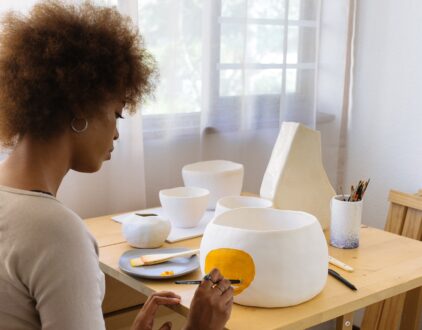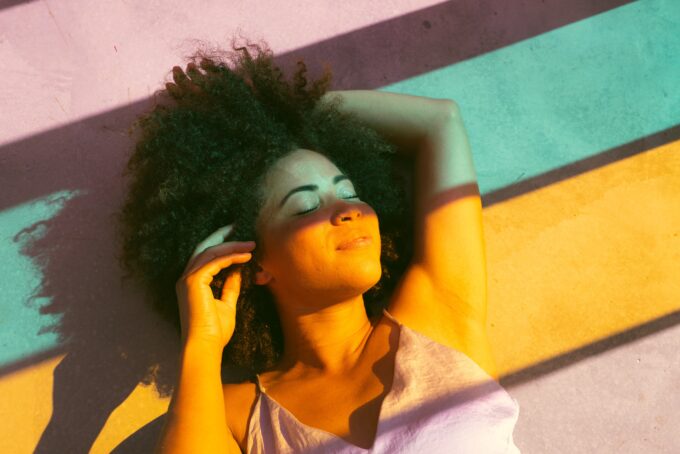Whether you’re an art collector, art lover, or all of the above, art can evoke emotion and reflect personality in your home. The right piece of art can transform a space, enhancing its aesthetic appeal while creating a mood or telling a story. The artists that create these works have stories of their own that influence the art they put out in the world.
On a recent trip to Bluffton, South Carolina, we became enamored with the work of artist Amiri Geuka Farris. A descendant of the Gullah Geechee people, Farris tells the stories of the history and culture of the Gullah Geechee corridor in his work. Although he grew up in Florida, Farris moved back to Bluffton, South Carolina, where his family is from, to immerse himself more in the Gullah Geechee culture. “Now I see the different aspects of the culture of what my grandmother told me about — the language, the food, the artistry, and all the things that make up the low country and the Gullah Geechee corridor,” Farris tells Home & Texture.

His stunning large-scale indigo pieces adorn the walls of the Montage Palmetto Bluff where visitors from all over the world are exposed to his work. “I feel very honored that they allowed me to have my work here [Montage Palmetto Bluff] and have a gallery space,” says Farris.

We had the privilege of sitting down with Farris to learn about his journey as an artist, his artistic process, and his upcoming work.
Home & Texture: How long have you been an artist, and how did you get into art?
Amiri Farris: I’ve pretty much been an artist all my life. My parents put me in adult art classes when I was 6 or 7. From there, I continued taking classes, and I went to the Savannah College of Art and Design and got my undergraduate in illustration and my master’s in painting. Since graduating, I became more of a professional artist.
H&T: You use a lot of indigo in your work. What is the significance of that?
AF: Indigo was one of the crops here in South Carolina and in the South. It actually made the South very rich. Most of the indigo was harvested by African American people and African descendants, which are now the Gullah Geechee people. I try to talk about that history through my artwork. Indigo is a very strong color, as you can see in the artwork. It really stands out, especially when used on cotton and white areas. It’s a color I’m really drawn to and has a rich history.

H&T: How do you tell the story of the Gullah Geechee people through your art?
AF: I wanted to capture the real essence of the Gullah Geechee people. I wanted to capture them doing utilitarian things, like working on the water, working with different foods, and creating things like nets and sweetgrass baskets. A lot of the Gullah Geechee elders pushed me to stay and tell that story — to keep those traditions going for the younger generation.
H&T: Can you talk about your process?
AF: Different elders like Dr. Emory Campbell, a well-known Gullah Geechee historian, would tell me different stories about growing up on the island. The stories the elders would share with me would be very illustrative and almost whimsical to imagine at that time how connected they were as people. From those stories, I develop scenes in my paintings.

H&T: What do you want people to take away from your work when they purchase a piece for their home?
AF: The main thing that I want to portray is that the Gullah Geechee people and African-American people in the low country are real people. They’re not a character. They still are real people holding on to the traditions that they carry over from Africa. I also want to capture the essence and the beauty of the low country. It’s a very unique area, and you know, just capturing that, the beauty and the essence in the painting is very important to me as well.
H&T: You currently have an exhibit in Charleston. Can you tell us more?
AF: The exhibit is currently at the Gibbes Museum of Art in Charleston. It runs from July 28 through September 15. That exhibit features more of my contemporary work. It’s called The Natural Duality in the Metaverse. That work is all about what the metaverse is. I use a lot of bright colors and symbolism and a lot of landscapes but in a very contemporary way.
You can keep up with Farris on Instagram and on his website.
popular posts
- 1It’s Black Business Month, So Let’s Go Shopping and #BuyBlack!
- 2These Home Decor Items Will Instantly Make Your Space Look Outdated
- 3Black-Owned Home Decor Stores To Support Across the United States
- 4A Look Inside Elon Musk's Tiny $50,000 House
- 57 Black and Multicultural Designers To Follow For Design Inspo
FOLLOW ALONG ON INSTAGRAM
#homeandtexture
Find us on social for more home inspiration where culture, personal style, and sophisticated shopping intersect to help you create a home where you love to live.








